Abstract
Introduction:
The purpose of this study is to use Youth Participatory Action Research (YPAR) methods and Photovoice to identify the perceived environmental factors that influence substance use among adolescents living at the U.S.-Mexico border.
Methods:
One academic and a local youth health coalition engaged in Youth Participatory Action Research (YPAR) using Photovoice and qualitative methods to examine the perceived factors influencing adolescent substance use in their border community.
Results:
Identified novel risk factors for adolescent substance use on the border included the normalization of drug trafficking, normalization of substance use, and cross-border access to substances. Novel protective factors included living in a close-knit binational community and having strong binational family and social support systems. The findings also illustrate a nexus of ‘factors’ wherein risk and protective elements overlap.
Conclusion:
This study contributes to the broader literature on international border health and how living in a border space influences adolescent substance use. The examination of influential border-bound factors provides a more complete understanding of the experiences of youth living on the U.S.-Mexico border, and informs the field of the importance of considering the border experience for future prevention and risk reduction efforts with border adolescents.
Keywords: Adolescent substance use, Youth participatory action research, Adolescents, Latino, Photovoice, U.S.-Mexico border
Introduction
An established body of literature explores how contexts and environments intersect with and shape substance use, and mediate substance use-related harms among adolescents (Rhodes et al., 2003). A ‘risk environment’ approach (Rhodes et al., 2003) emphasizes the environmental aspects of substance use-related harm, which then provides a more productive way of understanding and responding to substance use. This approach broadly defines the risk environment as the space (i.e., physical, social, economic, policy) in which a variety of factors interact to increase the chances of drug-related harm. It contextualizes the individual as constrained by power relations of gender, class, race and ethnicity, and poverty, and posits that individual level behavior change is difficult to achieve if not accompanied by policy and practice that attempts to address the structural (e.g., political and economic) conditions that contribute to substance use (Rhodes et al., 2003).
One environment absent from the literature is that of the borders between countries, and how border spaces influence adolescent substance use. Border health is characterized by the health care markets, regulatory environments, health laws, environmental factors and health care consumer and individual behaviors (risk and protective) that shape the health of immigrant and other populations living in the region intersected by the geopolitical boundaries of two or more nations (Zúñiga, 2012). Past border health research considers how living in a border space influences health outcomes in a variety of contexts and countries (Cardozo, Talley, Burton, & Crawford, 2004; Sabo et al., 2014; Wismar, Palm, Figueras, Ernst, & Van Ginneken, 2011). Arguably, borders with different environments may have distinct risk and protective influences on youth health behaviors. For example, the border environment between two developed countries with similar cultural and social norms, economies, and a stable political relationship, may differentially impact adolescent substance use when compared to a highly militarized border space between two countries with distinct cultural, economic, and political environments (e.g.. U.S. and Mexico). We use the context of the U.S.-Mexico border as an illustration of how the interplay of unique border-bound environmental factors might influence adolescent substance use.
Despite the sizeable body of research on substance misuse among the general population in the U.S., relatively little is known about substance use at the U.S.-Mexico border. The U.S.-Mexico Border Health Commission defines the border region as the 44 U.S. counties with most of their population within the 100-km limit of the U.S.-Mexico border (2010). Projections estimate that the border region population in 2015 was over 15.3 million people and roughly half identify as Latino or Hispanic (United States Environmental Protection Agency & Secretaria de Medio Ambiente y Recursos Naturales, 2016). Evidence suggests that Mexican-origin adolescents living on the border experience higher rates of substance use-related problems compared to non-border Mexican-American adolescents (Almodovar, Tomaka, Thompson, Mckinnon, & O’Rourke, 2006; McKinnon, O’rourke, Thompson, & Berumen, 2004). Little epidemiological data exist on substance use among adolescents living at the U.S.–Mexico border; however, it is well documented that Hispanic adolescents, in general, are more likely to engage in substance misuse when compared to youth from other ethnic groups and are more likely to have abused nearly all classes of drugs compared to other ethnic groups (Johnston, O’malley, Bachman, & Schulenberg, 2011; Partnership for Drug Free Kids, 2013). The risk of substance use might be exacerbated for adolescents residing on the U.S.-Mexico border due to its unique environmental context. Compared to non-border communities, border residents are disproportionately exposed to greater availability and lower cost of alcohol and pharmaceuticals, alcohol advertising, poverty, high unemployment, and rapid population growth (Caetano, Ramisetty‐Mikler, Wallisch, McGrath, & Spence, 2008; Caetano, Mills, & Vaeth, 2012; Caetano, Vaeth, Mills, & Rodriguez, 2013; Lange, Voas, & Johnson, 2002; Reingle, Caetano, Mills, & Vaeth, 2014; Wallisch & Spence, 2006). The misuse of prescription drugs is higher on the border than in the U.S. as a whole, which might be explained by the fact that drugs requiring a prescription in the U.S. are available for cheaper and without a prescription in Mexico (Wallisch & Maxwell, 2014). Proximity to the border, nearby drug trafficking, and the frequent interactions and movement of people across the border also could increase access to drugs (Lee et al., 2013). Other research suggests that the nature of the transnational population influences norms for alcohol and drug use among youth at the border (Borges et al., 2015; Lange et al., 2002). The border region is distinctive from non-border communities due to exposure to border stressors including border militarization, perceived ethnic discrimination, and acculturative stress, which have been shown to pose health risks to Hispanic border residents (Borges et al., 2015; Caetano et al., 2008, 2012; Caetano et al., 2013; Carvajal et al., 2013; Lange et al., 2002; Reingle et al., 2014; Sabo et al., 2014; Viruell-Fuentes, Miranda, & Abdulrahim, 2012; Wallisch & Spence, 2006). Further, one study found that perceived ethnic discrimination was linked to larger amounts and higher frequency of substance use, pro-substance use attitudes, and peer approval of substance use among Latino youth in general (Kulis, Marsiglia, & Nieri, 2009).
Nevertheless, it is understood that local risk environment can also limit substance use (Rhodes et al., 2003). For example, evidence suggests that, in some cases, proximity to the border may have a positive influence on health and social outcomes. Research indicates that strong cultural ties present at the border could serve as a protective factor against youth substance use, including strong familial and social support systems, lower levels of drug use in Mexico, drinking norms, and religiosity (Wallisch & Maxwell, 2014).
Prominent researchers in the field of substance use at the U.S.-Mexico border have called for further research that examines multiple risk domains, including border-bound stressors, environmental risk factors, and psychological factors, and how they might contribute to greater substance use and problems at the border (Caetano et al., 2008, 2012; Caetano et al., 2013; Lange et al., 2002; Lee et al., 2013; Reingle et al., 2014; Wallisch & Spence, 2006). The examination of environmental factors that influence substance use among adolescents is lacking, leaving a critical gap in the literature regarding adolescent substance use at the U.S.-Mexico border. Past research has emphasized the importance of how different methodological principles can be used to identify and analyze local drug use contexts in particular (Duff, 2007). For example, within the field of geography, Mason, Cheung, and Walker (2004)) used social network and Geographic Information Systems (GIS) data to form a detailed description and analysis of the social ecology of urban adolescent substance use. A lack of epidemiological data, coupled with the evidence to suggest that the border region is exceptionally unique due to its socioeconomic and sociocultural characteristics, warrants the need for a participatory approach to substance use research informed by the adolescents that live and interact in this environment.
Research in the field of participatory research shows that involving adolescents who are the focus of research positively influences what is researched, how research is conducted and the impact of research findings on those involved (Cammarota & Fine, 2008; Minkler & Wallerstein, 2011). This is especially important for adolescents whose voices are typically absent from the literature (e.g., immigrant youth or youth of color) (Cammarota & Fine, 2008). With roots in the pedagogy of Brazilian-born education reformer Paulo Freire (Freire, 1996), YPAR is a form of Participatory Action Research (PAR) that provides youth with the opportunity to study social problems affecting their lives and to determine actions to solve these problems (Cammarota & Fine, 2008). PAR is an approach that engages researchers and participants in collective, self-reflective inquiry so they can understand themselves and the world around them, and improve upon their circumstances (Livingston & Perkins, 2018). It combines two separate research concepts: participation – active involvement of “subjects” in the research process; and action – defining social problems and solving them (Livingston & Perkins, 2018). Further, PAR recognizes the sociopolitical origins of health and the disproportionate impact of substance use and related problems on disenfranchised groups (Baum, MacDougall, & Smith, 2006; Minkler & Wallerstein, 2011). YPAR is distinct from PAR in that it is youth-led, as opposed to being adult-led with or about youth (Cammarota & Fine, 2008). Youth learn how to conduct research (e.g., surveys, focus groups, Photovoice [photo documentation and interpretation of the phenomena under study], effectively becoming youth researchers and advocates for change (Jason & Glenwick, 2016). It empowers youth to engage in social action in their schools, communities, and at the policy level, which in turn influences their attitudes and behaviors (Cammarota & Fine, 2008). YPAR and PAR have been used in substance use research as approaches to engage vulnerable and underrepresented populations (e.g., minority youth, refugees, survivors of conflict) to examine influential factors for substance use in different contexts and engage in social action (Jardine & James, 2012; Maglajlic & Tiffany, 2006). For example, one PAR study in post-conflict Bosnia Herzegovina used mixed methods to explore influential factors for substance use and develop a community-specific prevention strategy (Maglajlic & Tiffany, 2006). Another YPAR project in Canada used qualitative methods to explore tobacco use in Native communities, resulting in a book written by youth aimed to raise awareness of tobacco use (Jardine & James, 2012).
The purpose of this paper is to present and discuss the findings of a Youth Participatory Action Research (YPAR) project (Cammarota & Fine, 2008) using Photovoice (Shimshock, 2008; Wang & Burris, 1994, 1997) to identify the perceived environmental factors that influence substance use among adolescents living at the U.S.-Mexico border. The project uses an asset-based approach in two ways; (a) acknowledging the youth researchers as experts because they live, work, and go to school in the border space, and thus are equipped to assess the factors influencing adolescent substance use in their community; and (b) exploring the protective elements of border communities, which will inform future prevention and risk reduction efforts.
Method
Study sample
The YPAR project was conducted in a rural border community in the southwestern U.S. from August 2017 until May 2018. The community has a population of less than 25,000. The lead author partnered with a local state-funded youth health coalition; a coalition with which the lead author has an established collaborative relationship. While the youth do not claim to be abstainers from substance use, the youth health coalition engages in health promotion and prevention activities. With a proven record of effecting social change, including passing local tobacco legislation and leading prevention initiatives in the community, the youth coalition was poised to successfully engage in this YPAR project. As per YPAR tenants (Cammarota & Fine, 2008), the 23 youth involved in the coalition comprised the research team, and also were the subjects of this research. Inclusion criteria required participants to be between the ages of 14 and 18, able to write and read in English and/or Spanish, current members of the health coalition, capable of providing informed consent or have parental consent if under the age of 18, and have lived in the target community or the Mexican sister city for the previous 12 months. Many U.S. citizen children who reside in the Mexican sister city cross the border to attend the local U.S. high school, which is a common practice in border communities. Thus, they are likely to be exposed to and influenced by the same environmental factors as U.S. residents. This study received IRB approval from the University of Arizona’s Human Subject’s Protection Program.
Photovoice process
The research team composed of the 23 coalition members, the coalition coordinator, and the lead author ESV engaged in the Photovoice process (Shimshock, 2008; Wang & Burris, 1994, 1997). The purpose of using the Photovoice method was to equip the youth researchers with the research skills necessary to photographically document what they perceive to be the environmental factors that increase risk of or protect against adolescent substance use in their border community. By using photographs, the youth researchers could capture their own perceptions and share them visually with the other members, thereby generating discussion and new perspectives of how their environment influences their behavior and that of their peers.
Like YPAR, the Photovoice process is based in Freirean pedagogy (Freire, 1996). The Photovoice process has three main goals: 1) to enable people to record and reflect their community’s strengths and concerns, (2) to promote critical dialogue and knowledge of important issues through large and small group discussion of photographs, and (3) to reach policymakers (Shimshock, 2008; Wang & Burris, 1994, 1997). The selected Photovoice curriculum (Shimshock, 2008) included two-hour sessions held once per week over the course of twelve weeks. The lead author facilitated the process and contracted a local photographer to provide the instructional session on photographic techniques.
We began our Photovoice project by collaboratively developing a set of norms that guided our collaboration: being present on time to participate, respect others’ opinions, and wholeheartedly commit to this collaborative work. To minimize the risk of social desirability bias (Grimm, 2010), the lead author emphasized the value of all perspectives and worked to create an environment in which differences could be aired constructively. Specifically, strategies included organizing the physical space to sit in a circle, and by setting the expectation that all youth researchers could take turns presenting their photographs. The research team agreed that, according to their group norms, they would practice active listening with all presenters, and then respectfully discuss the findings. Further, all research team members were considered “experts”, acknowledging the expertise, knowledge, and unique contributions of each individual. For example, the team agreed that each youth researcher lived, worked, and went to school in the border region, and thus each individual had their own lived experience that was of value to providing a comprehensive understanding of the perceived risk and protective factors influencing adolescent substance use.
During the first four of the twelve formal sessions the youth researchers learned Photovoice ethics and photographic techniques (Shimshock, 2008). The fifth through eighth sessions were photo expedition sessions to photograph what the youth researchers perceived to be environmental factors that might increase risk of or protect against adolescent substance use in their community. The lead author purchased and distributed ten digital cameras to the youth researchers for the study. They received a weekly prompt and took a digital camera home with them to take as many photos as desired. The youth researchers photographed whatever they wanted; however, for their safety, they were restricted from photographing human subjects, illicit activities, or unsafe spaces.
The youth researchers selected three photos per prompt and reflected on them using the SHOWed method on a narrative form to contextualize the photographs (Shimshock, 2008; Wang & Burris, 1994, 1997). The SHOWed method consists of five questions intended to challenge the photographer to explore the meaning, causes, and potential solutions related to the photographs: (1) What do you see here?; What is really happening here?; (3) How does this relate to your life?; (4) Why does this situation, concern, or strength exist?; and (5) What can we do about it? (Shimshock, 2008; Wang & Burris, 1994, 1997). At the photo expedition debrief sessions (weeks 9–12), they brought their photos and Photovoice narrative forms to share with the rest of the research team. During this phase, the research team debriefed on the previous week’s prompt and received the prompt for the following week. Table 1 describes the photo expedition sessions, the prompts and their corresponding definitions. Prompts were selected based on previous research on substance use on the U.S.-Mexico border (Borges et al., 2015; Caetano et al., 2008, 2012; Caetano et al., 2013; Carvajal et al., 2013; Lange et al., 2002; Reingle et al., 2014; Sabo et al., 2014; Viruell-Fuentes et al., 2012; Wallisch & Spence, 2006). We audio recorded the debrief sessions with permission from the youth researchers.
Table 1.
describes the photo expedition sessions, the prompts and their corresponding definition.
| Photo Expedition Sessions | Prompt | Definition |
|---|---|---|
| 1 | General Risk and Protective Factors | Border-bound factors that increase the risk of or protect against adolescent substance use in the community |
| 2 | Drug Trafficking | Movement, storage, or selling of drugs in the community |
| 2 | Poverty/Unemployment | Characteristics of and contributors to poverty and/or unemployment in the community |
| 3 | Cross border access to substances | Cross border mobility/ability to easily cross and purchase ATOD at age 18 (or no id), attend clubs at age 18 (or no id), and attend parties where alcohol is served to minors (on both sides of the border). Greater availability and lower cost of alcohol and prescription pharmaceuticals (on the Mexican side), increased alcohol advertising |
| 4 | Border stressors | Border militarization (e.g., law enforcement presence, U.S. Customs and Border Patrol presence, the border fence), perceived discrimination, immigration-related stress (i.e., immigration-related concerns for family, friends, or self) |
| 4 | Mexican culture | Specific cultural aspects that might be protective include the presence of strong family and social support systems, religiosity, and the ‘immigrant advantage’, which is defined as the fact that immigrants tend to be healthier, more resilient, and have strong work ethics and aspirations |
Analysis
The three types of data collected in this study include the Photovoice photographs, narratives, and recorded debrief sessions. Themes were identified through a synthesis of photographs, corresponding narratives, and excerpts from discussions.
The research team engaged in a three-stage group participatory analytic process to analyze the photographs and narratives (Wang & Burris, 1994, 1997). In the first stage, youth researchers selected the photographs that most accurately reflected the topic of inquiry (e.g., general factors that increase risk of, or protect against, substance use among adolescents). The second stage consisted of the youth researchers contextualizing, or telling stories about what the photographs mean (Wang & Burris, 1994, 1997). Youth researchers reflected on the collection of photographs and responded in writing (a “free-write”) posed by the SHOWed method to contextualize the photographs (Shimshock, 2008; Wang & Burris, 1994, 1997). Last, in the third stage of participatory Photovoice analysis, the lead author led the youth researchers in the use of affinity diagrams to conduct a thematic analysis to identify themes or theories that emerge both inductively and deductively (ASQ, 2017; Shimshock, 2008; Wang & Burris, 1994, 1997). The affinity diagram organizes a large number of ideas into their natural relationships and is ideal for sifting through large volumes of data and generating new ideas (ASQ, 2017). Without speaking, the entire research team reviewed photos and their narratives spread on a table and participated in grouping the related photos/narratives together in themes (e.g., normalization of drug trafficking, familism, cross-border access to substances). Next, the entire research team discussed and decided upon theme names and corresponding definitions, if not already assigned deductively (ASQ, 2017). We organized themes and their photos by their nature- either risk or protective (Sallis, Owen, & Fisher, 2015). This list of themes was then included in a preliminary codebook to analyze the narratives and the recorded debrief sessions.
The lead author transcribed the recorded debrief sessions verbatim and then presented these transcripts to the rest of the research team to discuss the codebook, interpretation of the data, and analytical questions. The youth researchers divided into four groups and each received an identical transcript. Each group read the transcript and collectively supplemented the preliminary codebook with themes that emerged during repeated reading of the transcript. The groups then came together to compare their codes. Thus, the codebook was completed using ongoing discussion and iterative analysis of the transcripts and confirmation of deductive–inductive coding structure (Patton, 2002). Due to time constraints, the lead author and one contracted researcher independently reviewed and hand-coded the remaining transcripts and the narratives using the codebook (Patton, 2002). Data from photographs, narratives, and the recorded sessions were triangulated by the lead author to identify the results (Patton, 2002). Specifically, data were analyzed separately, then converged to identify similarities and differences to determine how the three distinct methods affected the results (Patton, 2002). Comparing the data led to an iterative process in which data were explored more deeply. The combined data led to an enhanced understanding of the context of the border environment, and led to enhanced trustworthiness of the findings. The lead author then conducted member-checking activities during two research meetings to receive feedback on the interpretations of results, to diminish probability of analytic drift, and to validate the findings with the youth researchers.
Ensuring youth engagement in the project
YPAR-based methods were selected for this study as an innovative, asset-based approach to examine adolescent substance use in the borderlands from the perspective of the population most affected. YPAR principles emphasize that researchers should balance time and resources to expand the roles of youth beyond their role as solely a data source, and emphasize equitable power distribution, in order to promote the youth voice and enhance project outcomes (Gilbert, 2008; Livingston & Perkins, 2018). Nonetheless, Carey (2010) cites the practical imepdiments, ethical implications, and politicall dilemmas of participatory approaches, where participation maybe encouraged or increased but not address the power dynamics. Thus, the authors used the Reliability-Tested Guidelines for Assessing Participatory Research Projects by Mercer et al. (Minkler & Wallerstein, 2011) to guide youth engagement in this project. The guidelines define participatory research as systematic inquiry, with the collaboration of those affected by the issue being studied, for the purposes of education and of taking action or effecting change (Minkler & Wallerstein, 2011). The guidelines provide four specific domains of community participation to ensure representation from inception of the research question to dissemination of the research: participants and the nature of their involvement; their role in shaping the purpose and scope of the research; their role in research implementation and context; and their role in the dissemination of research outcomes. The authors attempted to address each domain. For example, the youth coalition was appropriate for the examination of factors influencing adolescent substance use on the border because they live, work, and go to school in that environment (i.e., participants and the nature of their involvement). The youth coalition aims to promote tobacco prevention message to their peers, focus on community-wide policy change and assist at school and community events. While the research question was developed by the lead author, the coalition had previously examined the factors influencing tobacco use in their community. Thus, they were interested in the broader examination of factors influencing substance use in general (i.e., role in shaping the purpose and scope of the research). The youth researchers were solely responsible for the data collection (i.e., photography). Analysis was primarily youth-driven, including debriefing the photographs, defining the themes, creating the codebook, and member-checking the results. Exceptions include the role of the lead author in coding the transcripts and triangulating the data (i.e., role in research implementation and context). Finally, the youth researchers engaged in community-level advocacy and policy-change efforts based on their results including a community forum and presenting at a conference (i.e., role in the dissemination of research outcomes).
Results
Participants
Participants included 23 adolescents ages 14–18 (mean age of 15.7 years), who were members of the coalition and resided in the target community or its Mexican sister city at the time of the study. Twelve female-identifying and 11 male-identifying coalition members participated. Seventy three percent (20 participants) identified as Hispanic and/or Mexican-origin.
Qualitative results are presented in an organized thematic fashion.
Struggling local economy
The youth researchers agreed that the most salient risk factor for adolescent substance use in the community was the depressed economy, characterized by the closure of local businesses, subsequent lack of jobs and career opportunities, and the closure of youth-friendly spaces. One member wrote about a photo that he took depicting the closure of a local movie theater (see Fig. 1)
Fig. 1.
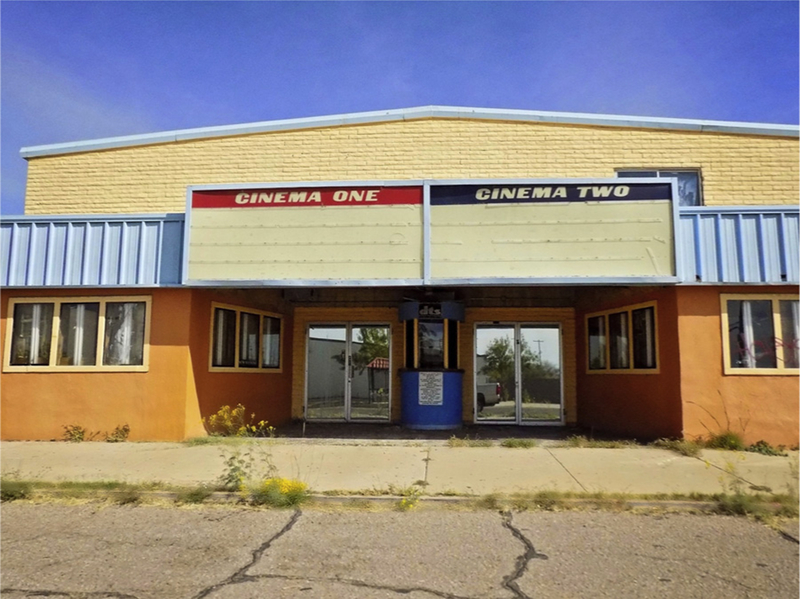
The Box Cinema.
I see “The Box” movie theater that closed down 2–3 years ago. It’s very empty-looking and has signs of disrepair such as graffiti. This building was the only movie theater in our town and a popular spot for people to go for fun on the weekend. Without this activity in our community, youth are forced to find other things to do and this can lead to starting destructive activities.
Disordered neighborhood
Youth researchers photographed the dilapidated spaces in their community, including shuttered businesses, graffiti-covered walls, broken windows, and litter. They commented that there is a local perception that no one outside of the community (e.g., residents of larger U.S. cities, state government) cares about their community or about border towns generally. They believe that border towns are considered to be bad places where all people traffic and use drugs. They expressed that this sentiment infiltrates community members’ perceptions of the town, and coupled with the failing economy, has led to the deterioration of civic pride, care for the community, and a sense of hopelessness. Youth researchers shared that this sense of hopelessness and indifference leads youth to use substances because they do not perceive there to be more or better opportunities. One youth researcher describes a photo of a graffiti wall (see Fig. 2):
Fig. 2.
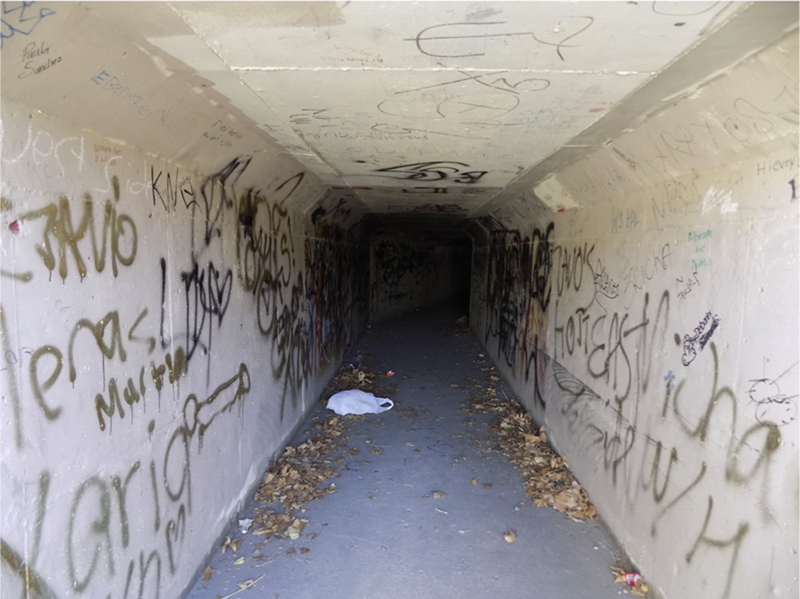
Graffiti.
I see graffiti on a building. The graffiti is acknowledging the problems that our city has. In our life we are surrounded by problems in our city that are never acted upon. I think it’s a strength and a concern because someone is recognizing that this is important, but we need to do something about it.
Cross-border access to substances
Many community members on both sides of the border cross daily for work, school, or commerce. Youth researchers expressed that this cross-border mobility increases access to alcohol and drugs among transnational youth. For example, they reported that youth purchase cheaper alcohol and tobacco on the Mexico side of the border, often without having to show identification. They also expressed that it is easy to access marijuana and other illicit drugs on the Mexico side of the border. Another unique characteristic of this transnational population is the ability to go to clubs or discotheques in Mexico where identification verification is not enforced. One youth member wrote about his photograph of a club frequented by local youth (see Fig. 3):
Fig. 3.
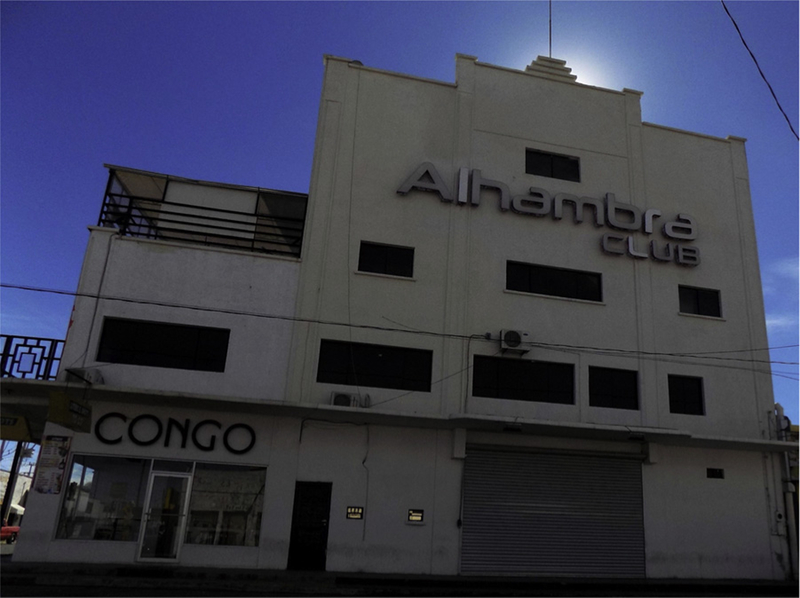
The Alhambra Club.
I see a club in Mexico. All the clubbing factors such as alcohol are accessible to minors. Many of our peers will visit this club and drink or use drugs illegally. It is a concern that minors are getting into things they shouldn’t be getting into.
The normalization of drug trafficking
The youth researchers agreed that the normalization of drug trafficking influences adolescent substance use. They defined drug trafficking as the movement (i.e., across the border; from place to place), storage (i.e., in homes or storage sheds), or sale of drugs. They reported that there is a historic and pervasive presence of drug trafficking in their community, which increases access to drugs and desensitizes youth to the harms of drug use. Youth researchers took photos of different modes of crossing drugs from Mexico into the U.S., specifically in semi-trucks driven across the border with drug cargo (see Fig. 4):
Fig. 4.

Big Trucks.
Big trucks are many times used to cross drugs across the border. This makes drugs more accessible and add to the problem of consumption in our community. Transportation is big in our town (jobs). With the big size of the truck is it easier to hide and cross more drugs.
Another youth researcher photographed repurposed paint buckets that are used to move drugs from place to place (see Fig. 5):
Fig. 5.
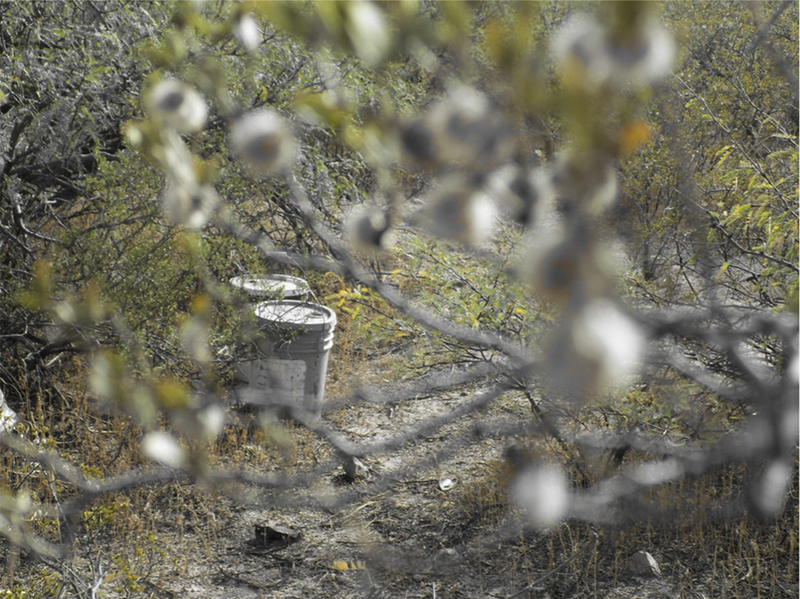
Buckets Through Mesquite.
I see two buckets through mesquite. I think this sort of represents how drugs are being trafficked through the desert. Drug trafficking goes through our town a lot.
Another photo depicted two students passing backpacks between each other at school, reflecting the movement of drugs in schools (see Fig. 6). Overall, youth researchers expressed a keen awareness of when, where, how, and who moves, stores and sells drugs in their community, exhibiting the normalization of drug trafficking in their community.
Fig. 6.
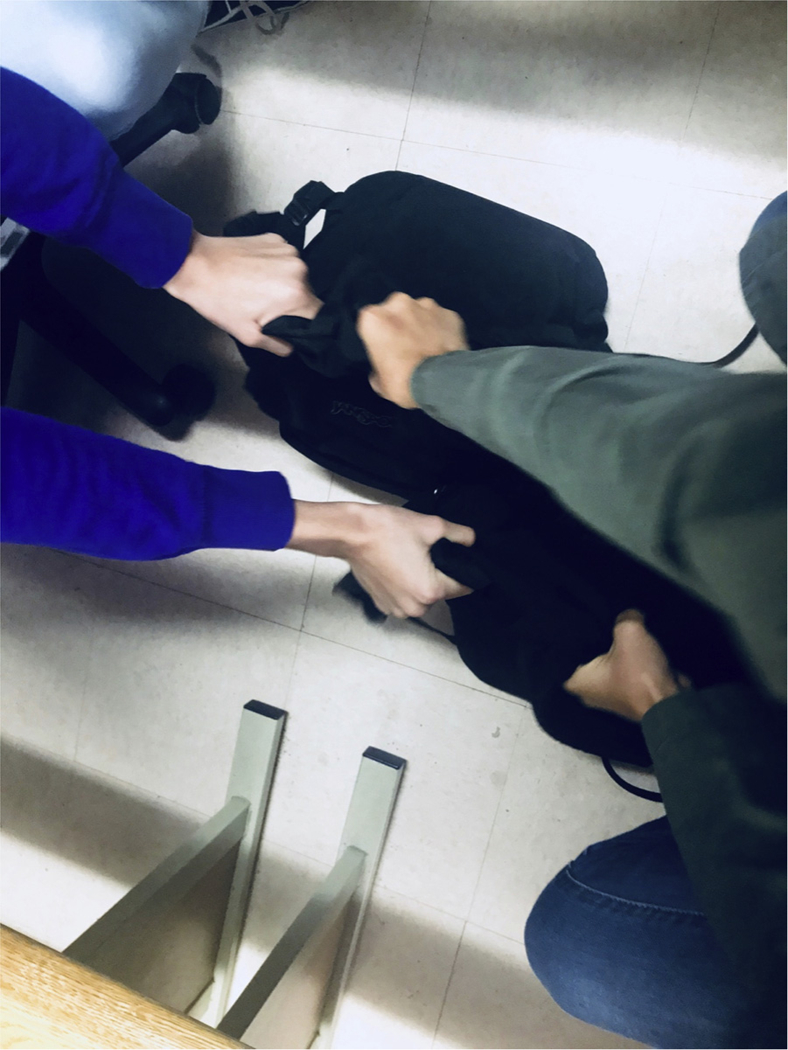
Passing Drugs at School.
I see two students passing backpacks between them. Drugs are passed around during class. Drugs are very accessible, especially in schools. It is a concern that students have easy access to drugs even in safe spaces likes schools.
In discussion of the photographs, another element characterizing the normalization of drug trafficking was the intergenerational nature of the drug trade in the community. Specifically, that the normalization of drug trafficking in the community is due to a generational dependence on the drug trade for economic reasons. For example, if grandfathers, uncles, cousins, and other family members are involved in the drug trade, youth expressed that this normalizes the drug trade for youth, and that the lack of sufficient jobs coupled with the high risk/high pay nature of the drug trade can be motivators to become involved as well. Relatedly, youth researchers reflected on the influence of drug cartels in their community. Drug cartels sometimes rely on recruitment of youth on both sides of the border to cross drugs across the border, and across the state to the larger Southwestern cities; to store the drugs between transitions; and to sell drugs in the community. Youth are particularly vulnerable to the cartels because they can make a large sum of money for one transaction, and the lack of jobs in the community leads to dependence on drug trafficking for income.
The normalization of substance use
Youth researchers perceived high prevalence of substance use in the community. Alcohol in particular was an integral part of socialization. During discussion of the photographs, they reported that youth are permitted, and even encouraged, to drink at social occasions on both sides of the border such as at family parties, quinceañeras (15th birthday parties for women), and weddings. Beyond their own consumption, youth researchers reported that these occasions expose youth to adults who drink large quantities of alcohol in social settings. One youth researcher described her uncles could drink a 30-pack of beer on their own during family parties. Further, male adolescents are often invited or even expected to partake in drinking. Another described a photograph of a dirty BBQ grill (see Fig. 7):
Fig. 7.
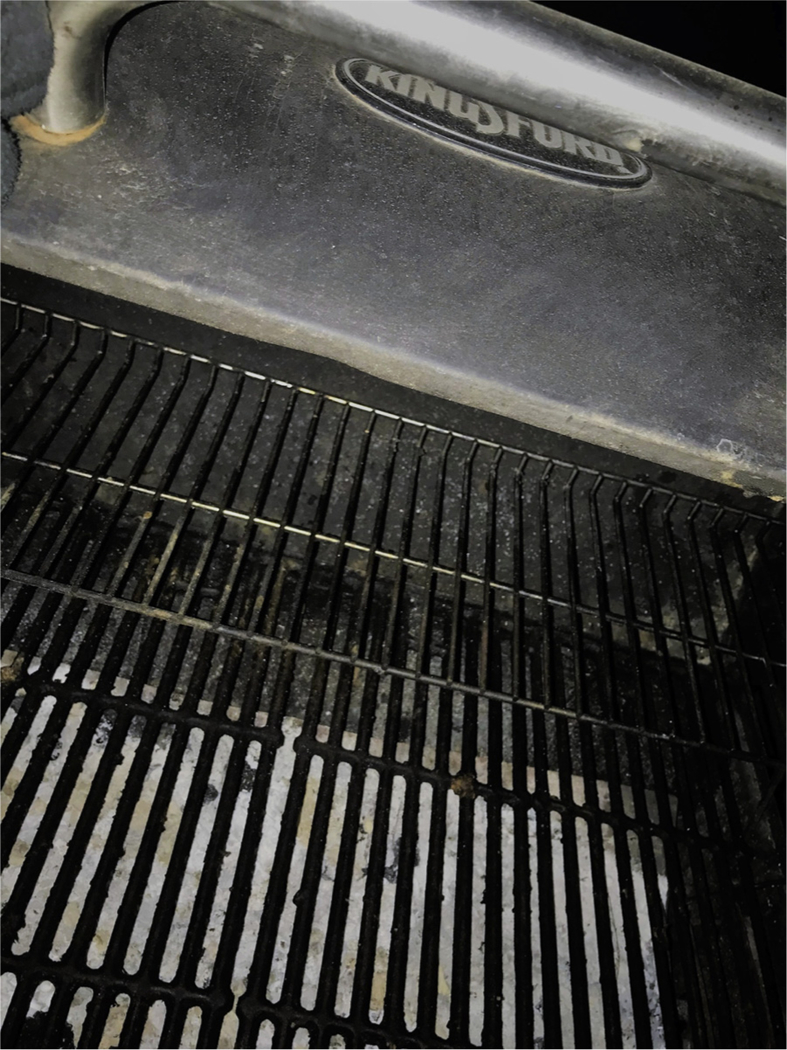
Grillz.
I see a dirty grill. …families typically have a BBQ every Saturday. We get together and make food. The parents are drinking and they say “oh ya know just take a sip”. That happens on both sides of the border. This could be a way that kids start using substance because they might have their first sip of alcohol at a family party. They could get hooked on it and they could start moving into more serious things like drugs. It depends on the person. Some people might have a drink with their family and they think it’s not that bad. There’re other times where the kids want to drink to be cool and it’s cool that they get to drink with their families.
Close-knit community
Youth researchers took photos illustrating the unity and cohesion of the sister cities. They shared that this sense of unity promotes local pride between the two communities and leads to collaborative problem solving, which could be a strength in the fight against adolescent substance use. They also expressed and wanted to promote that, contrary to perceptions that all border residents are connected to the drug trade, their community members are ethical, hardworking folks that want the best for their family and community. One youth researcher described a photo that he took of a painting of the “American Mexican Dreamer” (see Fig. 9):
Fig. 9.
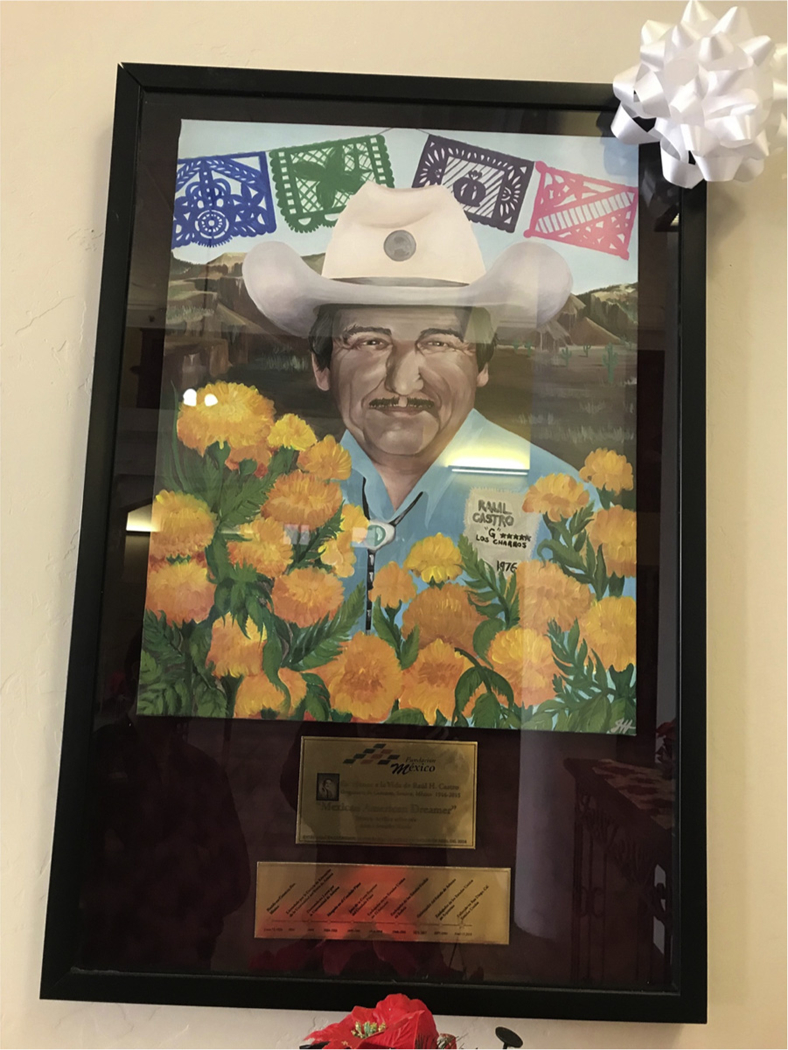
Mexican American Dreamer.
What is really happening is our family members or our parent’s motivation of living a good life in the United States, with their kids, which in return will help the kids live prosperously here…We did this (immigrate) so we don’t have to be dealing with these types of problems. It’s another thing to strive for dreams and opportunities, and not just give into drug abuse.
Binational family and social support
Binational family and social support were perceived to protective against adolescent substance use in the community. Youth researchers highlighted the binational nature of their family networks, and how special it was to feel supported by their caring Mexican culture on both sides of the border. They expressed that their families, teachers, and community leaders actively care for them and their futures, and maintain high expectations for the youth. They also indicated that they did not want to be associated with that type of behavior and that rumors move quickly in their small, close-knit community. One youth researcher wrote about her photo of a knitted Mexican blanket (see Fig. 10):
Fig. 10.

Knit.
This blanket is a representation of how close-knit Mexican and Mexican American families are. It is a strength because it makes you step back and makes you not want to do drugs because everyone is going to know. Your nana is going to know and then your nana is going tell your tia [aunt]. And then everyone is going to know and you’re going to be known as the family disgrace. Close families are ingrained in the culture. Family always comes first.
Youth friendly spaces
Youth researchers reported that youth-friendly spaces, including schools, churches, and local businesses, play a key role in preventing youth from using substances. One wrote about her photo of a local youth-friendly coffee shop where youth can go in the afternoons and weekends and stay away from other risky activities (see Fig. 8):
Fig. 8.

Art for Youth.
I see a safe place for teenagers to hang out and feel free to be themselves. It is designed for teens to feel welcome and to have them feel what a safe environment is. Teens got together to help build a stronger community by helping keep this business alive. We live somewhere where we don’t feel as safe in part of town, but there’s always one place where we can be at and talk to each other feel safe.
Youth-led advocacy and policy-change efforts
The third goal of YPAR is to reach policymakers (Shimshock, 2008; Wang & Burris, 1994, 1997). Thus, the youth researchers engaged in advocacy and policy-change efforts based on their results. Select Photovoice findings were displayed at a community-wide event celebrating the city. The youth researchers used this as a forum to present their research findings, with the objective of raising awareness of the risk and protective factors influencing adolescent substance use in their community. The research team collaboratively selected 24 photographs that best represented the identified themes. Photographs were printed on large foam posters and displayed with the corresponding SHOWed narratives in English and Spanish. The narratives included QR codes linked to audio files with the voices of youth researchers describing their photos in English and Spanish.
The youth researchers also developed local and state policy recommendations with the city’s mayor. Policy recommendations include: 1) Work with clubs and discoteques on the Mexico-side of the border to enforce stricter IDing. 2) Collaborate with local organizations and initiatives whose goals are to reduce substance use in the community. 3) Increase youth-friendly spaces in the community such as skate parks, movie theaters, community centers, and youth centers.
Discussion
The current study contributes to existing border health research by examining the unique border-bound environmental factors present at the U.S.-Mexico border and their influence on adolescent substance use. We analyzed the border space using a ‘risk environment’ approach to consider how specific environmental aspects influenced substance use-related harm (Rhodes et al., 2003). According to the youth that live and interact in this environment, the confluence of physical (i.e., the space between the two countries), social (i.e., normalization of drug trafficking and substance use), economic (i.e., struggling local economy), and policy (i.e., local and state disinvestment) factors present at the U.S.-Mexico border directly influence adolescent substance use for the youth living there. It is imperative that we consider that individual level behavior change is difficult to achieve if not accompanied by policy and practice that attempts to address the structural conditions that contribute to substance use among border youth (Rhodes et al., 2003).
Using YPAR and Photovoice based methods, the research team identified novel risk factors that are unique to border regions, including the normalization of drug trafficking, the normalization of substance use, and cross-border access to substances. They also identified risk factors that echo previous literature including living in a struggling local economy and disordered neighborhood. The perceived border-bound protective factors include living in a close-knit binational community, and having strong social support systems on both sides of the border. Other perceived protective factors, which coincide with previous literature, include having access to youth-friendly spaces. The youth researchers perceived their environment to having more risk than protective factors. Importantly, the findings also illustrate a nexus of ‘factors’ wherein risk and protective elements overlap, thereby challenging drug policy and border scholars to consider a more nuanced understanding of how border spaces influence adolescent health behavior.
Youth researchers perceived that the normalization of drug trafficking in their border community might influence adolescent substance use. Alarmingly, they expressed a keen awareness of the nature of drug trafficking, including the intergenerational nature of the drug trade and the active presence of drug cartels in their community, which they believe further normalizes drug trafficking and, more distally, the use of substances. This awareness exemplifies a disproportionately high exposure to drug trade-related activity, likely due to the border as a major point of entry for drugs, which may cause de-sensitization to the drug trade and drug use.
In a study on substance use in urban areas and colonias on the Texas-Mexico border, Wallisch and Spence (Wallisch & Spence, 2006) found that about 82% of border residents agreed or strongly agreed there was a lot of drug trafficking in their area. Interestingly, drug trafficking was seen by 20% of study participants as having possible economic benefits, and that drug dealing can be a good way for people to raise themselves out of poverty. Personal past-year drug use was not significantly related to the perceived prevalence of drug trafficking or to positive or negative attitudes toward trafficking; however, drug use was significantly related to the perception that drugs were easy to get and the perception of high substance use in the respondent’s neighborhood (Wallisch & Spence, 2006). These findings echo our youth researchers’ perception that drug trafficking is not only common and normalized, but is a viable economic activity in their border community. As long as the troubled economic state in rural border communities continues as illustrated by our study findings, along with the explosive demand for harder drugs in the U.S., jobs in the drug trade for border youth will continue to be available. This finding is supported by the risk environment approach which considers how the structural (e.g. economic) environment and social context of individuals is imperative to substance use prevention among adolescents (Rhodes et al., 2003).
Youth researchers perceived that the normalization of substance use also might pose credible risk for adolescents living on the U.S.-Mexico border. They observed a high prevalence of substance use in the community, especially in social settings where adolescents are in attendance. Musick, Seltzer, and Schwartz (2008) investigated how specific neighborhood-level norms (i.e., adults’ attitudes and behavior with respect to substance use) influenced these same individual-level outcomes (i.e., youth substance use). According to the authors, norms are communicated through the models neighbors provide of appropriate behavior, as well as through social interaction where residents exchange information about their values and the expected costs of violating rules of conduct (Musick et al., 2008). Their results suggest that norms affect teenagers’ behavior in neighborhoods where residents are willing to enforce rules of conduct. Specifically, teenagers were less likely to smoke as neighbors’ disapproval of smoking increased; however, they found no evidence of effects of neighborhood norms on drinking or drug use (Musick et al., 2008). This finding contradicts other studies that show that neighborhood drug use influences behavioral health and risk taking (e.g., substance use) among adolescents (Aneshensel & Sucoff, 1996; Furr-Holden et al., 2008; Milam et al., 2012). More research is necessary to determine to what degree neighborhood level norms influence adolescent individual substance use behaviors.
Despite the identified border-bound risk factors for adolescent substance use, youth researchers perceived numerous protective factors that might moderate this risk. For example, they observed that social support and familism were especially pronounced in their border community. In particular, they emphasized the binational dynamics of accessing large family support systems on both sides of the border. While there is a lack of literature on the nature of binational family support systems and adolescent substance use, a study of adolescents residing in the border city of Tijuana, MX indicated that parental support and parental monitoring were significant predictors of lower lifetime and recent substance use for adolescents (Becerra & Castillo, 2011). Further, another study investigated the moderating effect of peer networks on how neighborhood disorder is associated with substance use in a sample of primarily African American urban adolescents (Mason et al., 2017). The authors found that peer network moderates neighborhood disorder, and that the protective qualities of peer networks may be a promising approach for interventions seeking to reduce substance use, particularly among younger urban adolescents living in high risk neighborhoods (Mason et al., 2017).
Participants perceived that their close-knit binational community and feeling connected to their community protects them against substance use. To our knowledge this is the first study to identify binational support systems as a potential protective factor for substance use among border adolescents. This finding builds upon previous research showing that positive neighborhood sense of community (Lardier, MacDonnell, Barrios, Garcia-Reid, & Reid, 2017) may act as a buffer against substance use, while empowering adolescents to engage in community change (Garcia-Reid, Peterson, Reid, & Peterson, 2013; Speer, Peterson, Armstead, & Allen, 2013). Among Latino youth in particular, two studies found that neighborhood sense of community (i.e., as a protective-empowerment-based factor) moderated and reduced the effect perceived social disorganization had on substance use among primarily Latinos samples (Fagan, Wright, & Pinchevsky, 2014; Lardier et al., 2017). These findings support the need for Latino communities characterized by social disorganization to provide youth with ample opportunities to develop a positive neighborhood sense of community. Possible strategies include engaging adolescents with positive neighborhood organizations and mentors (Christens & Peterson, 2012), and organizing community-building events to create a sense of unity, cultural pride, and collectivism among community members (Lardier et al., 2017). Community-level activities have been found to begin reshaping Latino youths’ environment from social disorganization to communities that promote a healthy lifestyle and support cultural and familial values (Kennedy & Ceballo, 2013).
The authors acknowledge that this project used the framework of protective and risk factors as prompts, which directed the youth researchers’ photography and thematic analysis. This binary framing coupled with their role as a youth health coalition focused on health promotion and prevention (vs harm reduction) may have contributed to how the participants engaged in the project. As a result, their findings were biased by this framework, resulting in photographs, analysis and discussion depicting risk and protective factors. Interestingly, while the prompts and results were organized in a binary fashion (risk vs protective), the findings illustrate a nexus of ‘factors’ wherein risk and protective elements overlap. For example, familial and social cohesion are emphasized as protective; however, it is this same social cohesion that drives social gatherings wherein substance use occurs, and becomes socially encouraged and normalized (Valdez, Garcia, Ruiz, Oren, & Carvajal, 2018). Similarly, youth researchers perceived discothèques as purely risky, although existing literature suggests that identity and community can be created through club and substance use (rave) practices (Hunt, Moloney, & Evans, 2011). These findings contribute to previous research indicating that the harms of consumption co-occur with benefits (Fraser, Moore, & Keane, 2014), and that the dominant framing of drug use contributes to pathologizing people who use substances, while ignoring the positive effects (e.g., sociability) (Moore & Fraser, 2006). Thus, these findings prompt further interesting questions about how border youth navigate and negotiate such a nexus, and highlight the need for scholarship to understand this understudied population. Further, future research should consider theory-driven preventive interventions that encompass the complexity of risk and protective processes for adolescents residing in border spaces.
Strengths and limitations
This study has a number of strengths. Both YPAR and the Photovoice process were youth-led, and thus represent the perspectives and experiences of the population most affected. Importantly, Photovoice is appropriate for youth who may not be comfortable with written/verbal expression, thus allowing for a greater range of youth perspectives and contributing to the generalizability of the findings. This study adds novel information about the factors that influence adolescent substance use on the U.S-Mexico border, and may be informative for research in other border spaces. We acknowledge a number of limitations of our study. We restricted the Photovoice debrief sessions to 60-minutes, which limited the depth and breadth of the discussions. The findings may be threatened by social desirability bias (Grimm, 2010), meaning that the youth researchers could have taken photos that they perceived that the rest of the research team or their peers might want to see. Finally, for the safety of the coalition members, they did not photograph human subjects, illicit activities, or unsafe spaces. Consequently, these restrictions may somewhat compromise the ethics of the “voice” in Photovoice because youth researchers could not photograph freely. They took metaphorical pictures instead of physical pictures, which limits the illustration and depiction of their perceptions.
Conclusions
In summary, this YPAR study contributes to adolescent substance use research by exploring the environmental factors that influence substance use among adolescents living at the U.S.-Mexico border. In addition to studying the risk factors, this study utilized an asset-based approach by exploring the border-bound protective factors previously identified in the literature, which will inform future prevention and risk reduction efforts. This study provides YPAR-informed data that fill a critical gap in knowledge regarding the factors that influence adolescent substance use in the U.S.-Mexico border region. The examination of these factors provides a more complete understanding of border regions and the experience of youth living along the U.S.-Mexico border. This study also contributes to existing border health research by examining how living in border spaces may influence adolescent risk behaviors, as well as to inform the field of the importance of considering the border experience for future prevention and harm reduction efforts with border adolescents.
Acknowledgments
We acknowledge the commitment of the youth health coalition to actively engage in community building, service, and policy change with the purpose of building a better community. This project and its data are theirs. This research was supported by the National Institutes of Health under Ruth L. Kirschstein National Research Service Award F31MD012435 from the National Institute of Minority Health and Health Disparities; the Program in Migration and Health-California Endowment, UC Berkeley; and the Center for the Elimination of Health Disparities, Arizona Health Sciences, University of Arizona.
Footnotes
Declaration of Competing Interest
The authors have no financial or personal conflicts of interests to disclose.
References
- Almodovar A, Tomaka J, Thompson S, Mckinnon S, & O’Rourke K (2006). Risk and protective factors among high school students on the US/Mexico border. American Journal of Health Behavior, 30(6), 745–752. [DOI] [PubMed] [Google Scholar]
- Aneshensel CS, & Sucoff CA (1996). The neighborhood context of adolescent mental health. Journal of Health and Social Behavior, 293–310. [PubMed] [Google Scholar]
- ASQ (2017). Learn about quality: Affinity diagram Retrieved from http://asq.org/learn-about-quality/idea-creation-tools/overview/affinity.html.
- Baum F, MacDougall C, & Smith D (2006). Participatory action research. Journal of Epidemiology and Community Health, 60(10), 854–857. [DOI] [PMC free article] [PubMed] [Google Scholar]
- Becerra D, & Castillo J (2011). Culturally protective parenting practices against substance use among adolescents in Mexico. Journal of Substance Use, 16(2), 136–149. [Google Scholar]
- Borges G, Zemore S, Orozco R, Cherpitel CJ, Ye Y, Bond J, ... Wallisch L (2015). Co‐occurrence of alcohol, drug use, DSM‐5 alcohol use disorder, and symptoms of drug use disorder on both sides of the US–Mexico border. Alcoholism, Clinical and Experimental Research, 39(4), 679–687. [DOI] [PMC free article] [PubMed] [Google Scholar]
- Caetano R, Mills B, & Vaeth PA (2012). Alcohol consumption and binge drinking among US–Mexico border and non‐border Mexican Americans. Alcoholism, Clinical and Experimental Research, 36(4), 677–685. [DOI] [PMC free article] [PubMed] [Google Scholar]
- Caetano R, Ramisetty‐Mikler S, Wallisch LS, McGrath C, & Spence RT (2008). Acculturation, drinking, and alcohol abuse and dependence among Hispanics in the Texas–Mexico border. Alcoholism, Clinical and Experimental Research, 32(2), 314–321. [DOI] [PubMed] [Google Scholar]
- Caetano R, Vaeth PA, Mills BA, & Rodriguez LA (2013). Alcohol abuse and dependence among US–Mexico border and non‐border Mexican Americans. Alcoholism, Clinical and Experimental Research, 37(5), 847–853. [DOI] [PMC free article] [PubMed] [Google Scholar]
- Cammarota J, & Fine M (2008). Youth participatory action research. Revolutionizing education: Youth participatory action research in motion Routledge; 1–12. [Google Scholar]
- Cardozo BL, Talley L, Burton A, & Crawford C (2004). Karenni refugees living in Thai–Burmese border camps: Traumatic experiences, mental health outcomes, and social functioning. Social Science & Medicine, 58(12), 2637–2644. [DOI] [PubMed] [Google Scholar]
- Carey M (2010). Should I stay or should I go? Practical, ethical and political challenges to ‘service user’ participation within social work research”. Qualitative Social Work, 10(No. 2), 224–243. [Google Scholar]
- Carvajal SC, Rosales C, Rubio-Goldsmith R, Sabo S, Ingram M, McClelland DJ, & de Zapien JG (2013). The border community and immigration stress scale: A preliminary examination of a community responsive measure in two southwest samples. Journal of Immigrant and Minority Health, 15(2), 427–436. [DOI] [PMC free article] [PubMed] [Google Scholar]
- Christens BD, & Peterson NA (2012). The role of empowerment in youth development: A study of sociopolitical control as mediator of ecological systems’ influence on developmental outcomes. Journal of Youth and Adolescence, 41(5), 623–635. [DOI] [PubMed] [Google Scholar]
- Duff C (2007). Towards a theory of drug use contexts: Space, embodiment and practice. Addiction Research & Theory, 15(5), 503–519. [Google Scholar]
- Fagan AA, Wright EM, & Pinchevsky GM (2014). The protective effects of neighborhood collective efficacy on adolescent substance use and violence following exposure to violence. Journal of Youth and Adolescence, 43(9), 1498–1512. [DOI] [PMC free article] [PubMed] [Google Scholar]
- Fraser S, Moore D, & Keane H (2014). Habits: Remaking addiction London: Palgrave Macmillan. [Google Scholar]
- Freire P (1996). Pedagogy of the oppressed (revised) New York: Continuum. [Google Scholar]
- Furr-Holden C, Smart M, Pokorni J, Ialongo N, Leaf PJ, Holder HD, ... Anthony JC (2008). The NIfETy method for environmental assessment of neighborhood-level indicators of violence, alcohol, and other drug exposure. Prevention Science, 9(4), 245–255. [DOI] [PMC free article] [PubMed] [Google Scholar]
- Garcia-Reid P, Peterson CH, Reid RJ, & Peterson NA (2013). The protective effects of sense of community, multigroup ethnic identity, and self-esteem against internalizing problems among Dominican youth: Implications for social workers. Social Work in Mental Health, 11(3), 199–222. [Google Scholar]
- Gilbert N (2008). Researching social life London: Sage. [Google Scholar]
- Grimm P (2010). Social desirability bias. In Sheth JN, & Malhotra NK (Eds.). Wiley international encyclopedia of marketing John Wiley and Sons Ltd; 2010. Retrieved from http://onlinelibrary.wiley.com/doi/10.1002/9781444316568.wiem02057/abstract Accessed on April 20, 2018. [Google Scholar]
- Hunt G, Moloney M, & Evans K (2011). “How Asian am I?”: Asian American youth cultures, drug use, and ethnic identity construction. Youth & Society, 43(1), 274–304. [DOI] [PMC free article] [PubMed] [Google Scholar]
- Jardine C, & James A (2012). Youth researching youth: Benefits, limitations and ethical considerations within a participatory research process. International Journal of Circumpolar Health, 71(0), 1–9. 10.3402/ijch.v71i0.18415. [DOI] [PMC free article] [PubMed] [Google Scholar]
- Jason L, & Glenwick D (2016). Handbook of methodological approaches to community-based research: Qualitative, quantitative, and mixed methods Oxford University press. [Google Scholar]
- Johnston LD, O’malley PM, Bachman JG, & Schulenberg JE (2011). Monitoring the future national survey results on drug use, 1975–2010. Volume II, college students & adults ages 19–50 Institute for Social Research. [Google Scholar]
- Kennedy TM, & Ceballo R (2013). Latino adolescents’ community violence exposure: After‐school activities and familismo as risk and protective factors. Social Development, 22(4), 663–682. [Google Scholar]
- Kulis S, Marsiglia FF, & Nieri T (2009). Perceived ethnic discrimination versus acculturation stress: Influences on substance use among Latino youth in the Southwest. Journal of Health and Social Behavior, 50(4), 443–459. [DOI] [PMC free article] [PubMed] [Google Scholar]
- Lange JE, Voas RB, & Johnson MB (2002). South of the border: A legal haven for underage drinking. Addiction, 97(9), 1195–1203. [DOI] [PubMed] [Google Scholar]
- Lardier DT Jr., MacDonnell M, Barrios VR, Garcia-Reid P, & Reid RJ (2017). The moderating effect of neighborhood sense of community on predictors of substance use among Hispanic urban youth. Journal of Ethnicity in Substance Abuse, 1–26. [DOI] [PubMed] [Google Scholar]
- Lee E, Wilson C, Lara-Valencia F, de la Parra C, Van Schoik R, Patron-Soberano K, ... Selee A (2013). The state of the border report: A comprehensive analysis of the US-Mexico borderBorder Research Partnership Retrieved from https://www.wilsoncenter.org/sites/default/files/mexico_state_of_border_0.pdf on April 20, 2018. [Google Scholar]
- Livingston W, & Perkins A (2018). Participatory action research (PAR) research: Critical methodological considerations. Drugs and Alcohol Today, 18(1), 61–71. [Google Scholar]
- Maglajlic R, & Tiffany J (2006). Participatory action research with youth in Bosnia and Herzegovina. Journal of Community Practice, 14(1–2), 163–181. [Google Scholar]
- Mason M, Cheung I, & Walker L (2004). Substance use, social networks, and the geography of urban adolescents. Substance Use & Misuse, 39(10–12), 1751–1777. [PubMed] [Google Scholar]
- Mason MJ, Light JM, Mennis J, Rusby JC, Westling E, Crewe S, ... Flay BR (2017). Neighborhood disorder, peer network health, and substance use among young urban adolescents. Drug and Alcohol Dependence, 178, 208–214. 10.1016/j.drugalcdep.2017.05.005. [DOI] [PMC free article] [PubMed] [Google Scholar]
- McKinnon SA, O’rourke KM, Thompson SE, & Berumen JH (2004). Alcohol use and abuse by adolescents: The impact of living in a border community. Journal of Adolescent Health, 34(1), 88–93. [DOI] [PubMed] [Google Scholar]
- Milam AJ, Furr-Holden CD, Whitaker D, Smart M, Leaf P, & Cooley-Strickland M (2012). Neighborhood environment and internalizing problems in African American children. Community Mental Health Journal, 48(1), 39–44. [DOI] [PMC free article] [PubMed] [Google Scholar]
- Minkler M, & Wallerstein N (2011). Community-based participatory research for health: From process to outcomes John Wiley & Sons. [Google Scholar]
- Moore D, & Fraser S (2006). Putting at risk what we know: Reflecting on the drug-using subject in harm reduction and its political implications. Social Science & Medicine, 62(12), 3035–3047. [DOI] [PubMed] [Google Scholar]
- Musick K, Seltzer JA, & Schwartz CR (2008). Neighborhood norms and substance use among teens. Social Science Research, 37(1), 138–155. [DOI] [PMC free article] [PubMed] [Google Scholar]
- Patton MQ (2002). Designing qualitative studies. Qualitative Research and Evaluation Methods, 3, 230–246. [Google Scholar]
- Partnership for Drug Free Kids (2013). The partnership attitude tracking study Retrieved from https://drugfree.org/wp-content/uploads/2014/07/PATS-2013-FULL-REPORT.pdf Accessed on March 15, 2018.
- Reingle JM, Caetano R, Mills BA, & Vaeth PA (2014). The role of immigration age on alcohol and drug use among border and non‐border Mexican Americans. Alcoholism, Clinical and Experimental Research, 38(7), 2080–2086. [DOI] [PMC free article] [PubMed] [Google Scholar]
- Rhodes T, Lilly R, Fernández C, Giorgino E, Kemmesis UE, Ossebaard HC, ... Spannow KE (2003). Risk factors associated with drug use: The importance of ‘risk environment’. Drugs Education Prevention & Policy, 10(4), 303–329. [Google Scholar]
- Sabo S, Shaw S, Ingram M, Teufel-Shone N, Carvajal S, de Zapien JG, & Rubio-Goldsmith R (2014). Everyday violence, structural racism and mistreatment at the US–Mexico border. Social Science & Medicine, 109, 66–74. [DOI] [PubMed] [Google Scholar]
- Sallis JF, Owen N, & Fisher E (2015). Ecological models of health behavior. Health Behavior: Theory, Research, and Practice, 5, 43–64. [Google Scholar]
- Shimshock K (2008). Photovoice project organizer and facilitator manual Retrieved from https://deepblue.lib.umich.edu/handle/2027.42/108548 Accessed on March 8, 2017.
- Speer PW, Peterson NA, Armstead TL, & Allen CT (2013). The influence of participation, gender and organizational sense of community on psychological empowerment: The moderating effects of income. American Journal of Community Psychology, 51(1–2), 103–113. [DOI] [PubMed] [Google Scholar]
- United States Environmental Protection Agency, & Secretaria de Medio Ambiente y Recursos Naturales (2016). Border 20:20-U.S. Mexico environmental program: State of the border region indicators interim report 2016 Retrieved from https://www.epa.gov/sites/production/files/2017-01/documents/state_of_the_border_region_2016_122216.pdf.
- U.S.-Mexico Border Health Commission (2010). Health disparities and the U.S.-México border: Challenges and opportunities Retrieved from https://www.ruralhealthinfo.org/assets/1076-3987/health-disparities-united-states-mexico-border-challenges-and-opportunities.pdf Accessed on May 3, 2018.
- Valdez LA, Garcia DO, Ruiz J, Oren E, & Carvajal S (2018). Exploring structural, sociocultural, and individual barriers to alcohol abuse treatment among Hispanic men. American Journal of Men’s Health, 12(6), 1948–1957. [DOI] [PMC free article] [PubMed] [Google Scholar]
- Viruell-Fuentes EA, Miranda PY, & Abdulrahim S (2012). More than culture: Structural racism, intersectionality theory, and immigrant health. Social Science & Medicine, 75(12), 2099–2106. [DOI] [PubMed] [Google Scholar]
- Wallisch LS, & Maxwell J (2014). Multiple trends in alcohol and drug use and treatment utilization on both sides of the border. Presentation, Center for Social Work Research, University of Texas at Austin. [Google Scholar]
- Wallisch LS, & Spence RT (2006). Alcohol and drug use, abuse, and dependence in urban areas and colonias of the Texas-Mexico border. Hispanic Journal of Behavioral Sciences, 28(2), 286–307. [Google Scholar]
- Wang C, & Burris MA (1994). Empowerment through photo novella: Portraits of participation. Health Education Quarterly, 21(2), 171–186. [DOI] [PubMed] [Google Scholar]
- Wang C, & Burris MA (1997). Photovoice: Concept, methodology, and use for participatory needs assessment. Health Education & Behavior, 24(3), 369–387. [DOI] [PubMed] [Google Scholar]
- Wismar M, Palm W, Figueras J, Ernst K, & Van Ginneken E (2011). Cross-border health care in the European Union: Mapping and analysing practices and policies. Cross-border health care in the European Union: Mapping and analysing practices and policies [Google Scholar]
- Zúñiga ML (2012). In Loue S, & Sajatovic M (Eds.). Border health. Encyclopedia of immigrant health (pp. 299–305). New York, NY: Springer New York. [Google Scholar]


